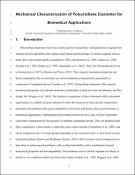Options
Mechanical characterisation of polyurethane elastomer for biomedical applications
Author(s)
Date Issued
2010-01
Date Available
2013-09-27T12:12:15Z
Abstract
Mechanical testing and modelling of a material for biomedical applications have to be based on conditions representative of the application of interest. In this work, an ether-based polyurethane elastomer is used to build mock arteries. The aim is to study the behaviour of arteries under pulsatile loading conditions and how that behaviour changes with the development and progression of atherosclerosis. Polyurethane elastomers are widely used as biomaterials, e.g. in tube form for bypasses and catheters. However, their mechanical behaviour has not been extensively characterised. This work establishes the variations in the behaviour of polyurethane elastomer with temperature, humidity and strain rate and also reports planar and equibiaxial tension, relaxation, creep and cyclic test results, providing a comprehensive characterisation of the material. Test results are used to determine the properties of the polyurethane elastomer and in the selection of a representative material model for future simulations of arterial behaviour and the development of atherosclerosis. The results show that the behaviour of the elastomer is significantly dependent on both humidity and temperature, with Young’s modulus of 7.4 MPa, 5.3 MPa and 4.7 MPa under dry-room temperature, wet-room temperature and wet at 37 ∘C conditions, respectively. The elastomer also exhibits rate-dependent viscoelastic behaviour. Yeoh’s hyperelastic material model provided the best fit to the entire range of experimental data. The Neo-Hookean model provides a good fit at small strain but significantly diverges at large strains. Nevertheless, in applications where deformations are relatively small, i.e. below 15%, the Neo-Hookean model can be used.
Type of Material
Journal Article
Publisher
Elsevier
Journal
Journal of the Mechanical Behavior of Biomedical Materials
Volume
3
Issue
1
Start Page
51
End Page
62
Copyright (Published Version)
2010 Elsevier
Language
English
Status of Item
Peer reviewed
This item is made available under a Creative Commons License
File(s)
Loading...
Name
Mechanical Characterisation of Polyurethane Elastomer for Biomedical Applications done.pdf
Size
1.8 MB
Format
Adobe PDF
Checksum (MD5)
7a62028b5efaf8750cf514749c1c7c68
Owning collection